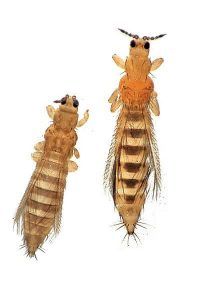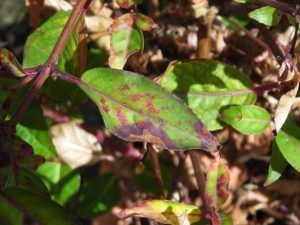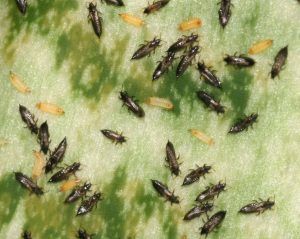Suntan Virus: [Characteristics, Detection, Effects and Treatment]

What is suntan virus?
 It is a disease present in open-air and greenhouse tomato crops, which can cause great economic damage after causing the destruction of the plants.
It is a disease present in open-air and greenhouse tomato crops, which can cause great economic damage after causing the destruction of the plants.
Belonging to the Tospovirus genus of the Bunyaviridae family, it is an almost spherical virus surrounded by a lipid envelope.
It has such genetic variability that it allows it to overcome the resistance that plants have to control it. And on top of that, it is also capable of adapting to changing conditions.
It prefers tropical, subtropical, and temperate climates. But to be honest, this tomato spotted wilt virus (TSWV) has been able to spread with great ease practically throughout Europe and manages to damage around 550 species from around 70 botanical families.
The thrips or thrips (Frankliniella occidentalis) is responsible for the transmission of this virus, which bites a plant, infecting it.This means that the virus does not have the ability to move on its own.
It spreads only with the help of an insect vector that acquires it from a contaminated plant and takes it to another, injecting it with the disease. Species of thrips that are especially vectors of this virus are Frankliniella occidentalis, or flower thrips, which has a great fertilizing capacity, as well as Trips tabaci.
Frankliniella occidentalis arrived in Spain in 1986, coming from substrates or infected plant material. And it manifested itself as a plague in Murcia, in 1988, feeding on leaves, flowers and fruits, thanks to a perfect mechanism of injecting saliva into plant tissues, causing injuries.
A single female is capable of depositing about 100 eggs, below the epidermis of the plant, damaging it as well.Adult insects are only vectors, when they acquire the virus in the larval stage, being able to transmit the disease throughout their lives, estimated at a maximum of 40 days.
A common form of contamination occurs when transplanting plants under a greenhouse environment.
How can we identify it?
Among the main symptoms that indicate the infection of the plant by this powerful virus, we have the following:
- The leaves turn yellowish, bronze in color, and noticeably reduce their size, with older or older ones becoming wrinkled very quickly.
- Precisely in tomatoes and peppers, the leaves are filled with spots in the form of arabesques or engravings on the leaves, formed by lines of a lighter color.
- The main characteristic is precisely that the leaves seem to be bronzed, due to the rounded and elongated yellow spots that are shamelessly shown.
- But in lettuce, for example, there is necrosis at the edge of the leaves and small, rounded brown spots with a dark brown halo.
- Red, yellow and green spots are usually seen on the fruits, which appear in the form of rings, although generalized necrosis can also occur, damaging the fruit completely.
- Another symptom is the absence of fruit production.
- In the worst case, there are plants that do not show visible symptoms and that allows the virus to easily spread to other crops.
- That is why it is recommended to take a sample and perform a DAS-ELISA Test to guarantee healthy cultures.
- When the crop reaches a high level of infection, it is necessary to destroy it completely and not replant non- resistant varieties on that site.
- Diseased crop residues must be destroyed immediately after detection of the disease and apply an insecticide + a herbicide.
What plants does the suntan virus affect?
 Ornamental plants, mainly fruit trees, are a sure victim of this TSWV virus. But cucurbits and dicotyledons, as well as some grasses, are also mostly damaged.
Ornamental plants, mainly fruit trees, are a sure victim of this TSWV virus. But cucurbits and dicotyledons, as well as some grasses, are also mostly damaged.
The preferred hosts of this virus are: potatoes, tomatoes, aubergines, lettuce, endives and artichokes. Likewise, it can lodge in weeds that serve as support to pass to the crops.
In tomato crops, therefore, it is necessary to exercise effective control over the proliferation of pests and maintain a correct sanitation process for all agricultural implements.It is worth noting that the disease does not affect consumers, only the plants.
How to fight the suntan virus?
 Effective controls are difficult to achieve, so prevention is vital to keeping tomato plantations, one of the world’s most sought-after vegetables, healthy.
Effective controls are difficult to achieve, so prevention is vital to keeping tomato plantations, one of the world’s most sought-after vegetables, healthy.
And there are currently no phytosanitary products capable of curing the disease.Let’s look at some practices that should never be abandoned.
- Management of certified and previously disinfected seeds when they do not come from reliable sources.
- Acquisition of varieties resistant to this and many other viruses and diseases, which have their phytosanitary passport.
- Perform regular checks to identify plants suspected of disease.
- Isolation and destruction of infected plants. Ideally, incinerate them. And the surrounding ones must also be eliminated for prevention.
- Elimination of mechanical work for the extermination of weeds, because these weeds, if they are contaminated, can easily spread the virus to the crops.
- Extermination of the thrips plague, with the application of effective insecticides that respect the auxiliary fauna, especially the Orius and Aeolothrips.
- Products should be alternated, not repeating them is the best thing to avoid resistance to it.
What are the best products to eliminate the suntan virus?
 There are no specific products, only with the correct adoption of preventive measures, it is possible to combat this virus that is so harmful to the crops of many vegetable items that are very useful in meeting the food needs of millions of people around the world.
There are no specific products, only with the correct adoption of preventive measures, it is possible to combat this virus that is so harmful to the crops of many vegetable items that are very useful in meeting the food needs of millions of people around the world.
However, some insecticides to combat thrips are especially effective.
Some commercial names are: Sunspray, based on summer oil -85; Align, with 3,2-azadirachtin; Dicarzol, with formetanate-50(T+); Match 5 EC, with luferunón-5 (applicable only in peppers), among other commercial brands that bring their application instructions.
These products must be combined with preventive measures and with sticky traps and barriers that prevent, for example, the vector from entering the greenhouse.
Another formula of great proven effectiveness is to exercise biological control over thrips, introducing natural predators that finish it off, without damaging crops or the environment.For this reason, the anthocorids of the genus Orius and mirids, such as Dicyphus tamaninii and Macrolophus caliginosus, must be preserved.




